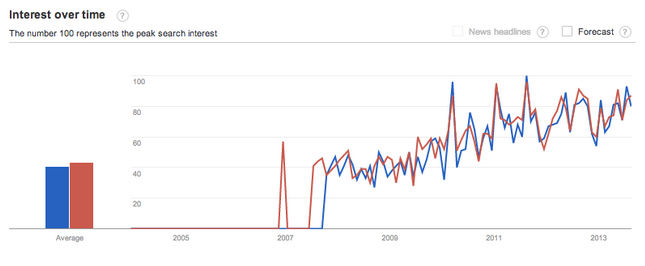When Andrew Yang noticed a young employee demoralized by undercompensation and having to scrounge for enough money to pay to attend friend’s weddings, he didn’t rush to the rescue. “In my old company, I would have pushed his pay to market, as he was doing very good work,” he wrote in his post on non-profit martyrdom, “But in the non-profit, I hesitated, thinking that maybe his suffering was necessary, despite my knowing that he was being paid far less than would have been the case in another setting.” This idea that “suffering is necessary” for social good has been part of the non-profit narrative for a long time. We honor people who sacrifice donations and time and expect our supporters to give something up for social good.
The growth in social entrepreneurship is changing this paradigm by giving new options to make an impact without having to be a overworked, underpaid, under-appreciated non-profit employee. This week I ran across a fantastic piece by Leanne Pittsford, founder and CEO of Start Somewhere and manager of the popular Tumblr “When You Work at a Nonprofit.” She used Google Trends to take a look at changes in search terms people were using to find employment. She found people searching for “nonprofit jobs” (blue line) and “non-profit jobs” (red line) have gone down dramatically in the past decade.
However when she looked at the people searching for jobs at “jobs social enterprise” (blue line) and “social enterprise jobs” (red line) both had increased.
So why is that less people are looking for nonprofit jobs even though there is an increase in people looking for social good jobs? Pittsford believes it is a sign of the sinking reputation of the non-profit industry which has a history of employee mistreatment in the name of a good cause. “Nonprofit is losing bright, motivated, socially-minded people, who now have another option for a career with meaning.” she writes in her blog, “And this option has afforded these bright, socially-minded people the things we have not: innovation, use of technology, well-paying salaries, and growth opportunities.” The story I believe these graphs tell is the promise of a new age of social enterprise and a redefinition of social good, one that hacks some of our more selfish natures to do social good rather then rely on “true altruism.” Sacrifice is no longer the only road necessary to make an impact.
It reminds me of a quote that struck me a few months ago. “The world could eliminate extreme poverty for about $45 billion a year,or roughly the amount spent on movie tickets annually worldwide,” a Harvard economist estimated. I don’t think the nonprofit sector can access that kind of money through altruism alone. Think how much money is spent every year publicizing a movie, engaging us, and drawing us in. Yet most people wouldn’t know where to begin to give $8 to help solve poverty. What if doing good were as easy and fun as going to the movies? What if we put the fun back in fundraising?
Those of us in the social change world have always been afraid to admit there is a selfish bone in our body. The public wants social good to happen with pure intentions, devoid of the dark stains of capitalism and self-interest. I was having a discussion with a friend about TOMS shoes and she brought up the point that “it would be much more effective if people just gave their money to a non-profit who could buy several pairs of shoes, instead of buying a pair of shoes for yourself where only one goes to someone in need.” That’s true if we lived in a world where we had plenty of money to give and no need for shoes ourselves. “How much money have you donated to a charity that provides shoes to those in need this year?” I asked her, “is it more than what you’ve spent on shoes?” My guess is many of us would answer no to this question. It’s not a bad thing; it’s reality, and new social enterprises allow us to benefit ourselves while benefiting other people as well.
While Pittsford’s graphs focus on how people are seeking on jobs in social good, my guess is that we are also seeing changes in how people are seeking out social good organizations to support with volunteer hours and donations. The social rewards of giving back are worthwhile but your needs should also be respected. As Scott Burkholder wrote in an earlier ChangeEngine blog post on the Tyranny of Low Overhead, “I think society wrongfully assumes that because creating art and social change makes people feel good, that should be sufficient compensation. It is not. If it is valuable to society, society should at least sustain and maybe even reward the change that is created.” We are beginning to see a new breed of organizations that don’t require us to suffer for our cause and in the end that’s a more sustainable and effective practice. No one can live forever on good will alone.





Great post, Robyn. The thing about something like TOMS shoes, though, is that as much as they dine out on it, social change is an extra, not integral to their mission. It’s a happy byproduct of their business strategy that they use for marketing purposes, which is totally legitimate. But it would be much the same if Nike hooked up with a traditional non-profit that provides shoes to those who can’t afford them (no doubt they already do this). Find me a social enterprise that can actually make a handsome profit off of providing shoes to those who can’t afford them, without exploiting them, and a shiny Nobel prize in both peace and economics is yours.
I feel their pain, but it’s a rite of passage if you’re taking the nonprofit/not-for-profit career path. A staggering amount of moons ago, I received a job offer from Children’s Hospital (now Children’s National Medical Center). I had already done some contract work there, so the shitty working conditions would have been no surprise. The only way the commute from Baltimore wouldn’t have been a hellish nightmare is if I had wheels (which I did) AND worked second or third shift or some sort of “offset” shift, which many employers in and around DC are doing now, but that didn’t exist back then. MARC to Union Station to Metro to a bus ride? Are you serious? But I still considered taking the job. Call it altruism, social conscience, whatever. But when the hiring manager slid that little piece of paper with my salary offer across the desk and I grabbed it up and did the math…ugh. I literally could not have afforded to work there. Is the reputation of the non-profit sinking? Maybe. But it’s been the shits for quite a while…
[…] Last week and throughout my Thagomizer posts, I often give glowing reviews to social enterprises. However this week I’d like to look at the failures of many of the businesses I’ve praised. While social enterprise has provided a new way of funding social change, it has not been as effective at producing impact. Sure most social enterprises have positive outputs: shoes provided to the poor, increased availability of affordable health services, microloans for businesses. However while models like Toms Shoes provide a way forward for funding, it also represents a step back in the way we address poverty. […]
[…] [Reposted by ChangeEngine] […]